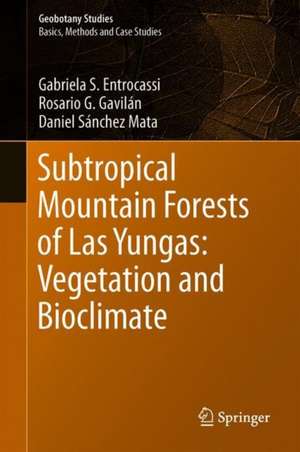Subtropical Mountain Forests of Las Yungas: Vegetation and Bioclimate: Geobotany Studies
Autor Gabriela S. Entrocassi, Rosario G. Gavilán, Daniel Sánchez-Mataen Limba Engleză Hardback – 27 noi 2019
The richness in species demonstrates that these forests are substantially more diverse than other subtropical mountain woodlands. 103 diagnostic (characteristic or indicator) species were selected, of which 29 are dominant, 67 are exclusive, selective, preferential or differential, and 7 are stenoic. In addition, 13 communities were identified and characterized. These forests can be attributed to the Bolivian-Tucuman biogeographical province (South-Andean Region, Neotropical Sub-Kingdom). They are seasonal, semi-deciduous or evergreen micro- and mesowoodlandsgrowing on foothills, hillsides, ravines, gorges and the edges of mountain ranges (terrestrial communities), as well as river terraces and beaches (riparian communities).
Thanks to the range of new findings, the content presented here will benefit experts in related fields such as geographers, ecologists and botanists, but also teachers, nature guides, those involved in the management of forest or conservation areas, and policymakers.
| Toate formatele și edițiile | Preț | Express |
|---|---|---|
| Paperback (1) | 636.12 lei 6-8 săpt. | |
| Springer International Publishing – 27 noi 2020 | 636.12 lei 6-8 săpt. | |
| Hardback (1) | 566.77 lei 3-5 săpt. | +20.60 lei 5-11 zile |
| Springer International Publishing – 27 noi 2019 | 566.77 lei 3-5 săpt. | +20.60 lei 5-11 zile |
Din seria Geobotany Studies
- 15%
 Preț: 643.00 lei
Preț: 643.00 lei - 15%
 Preț: 636.80 lei
Preț: 636.80 lei - 15%
 Preț: 704.04 lei
Preț: 704.04 lei - 19%
 Preț: 550.79 lei
Preț: 550.79 lei - 15%
 Preț: 638.24 lei
Preț: 638.24 lei - 15%
 Preț: 651.51 lei
Preț: 651.51 lei - 15%
 Preț: 649.06 lei
Preț: 649.06 lei - 20%
 Preț: 589.58 lei
Preț: 589.58 lei - 18%
 Preț: 961.10 lei
Preț: 961.10 lei - 15%
 Preț: 644.95 lei
Preț: 644.95 lei - 15%
 Preț: 662.80 lei
Preț: 662.80 lei - 15%
 Preț: 640.24 lei
Preț: 640.24 lei - 18%
 Preț: 945.30 lei
Preț: 945.30 lei - 18%
 Preț: 948.61 lei
Preț: 948.61 lei - 18%
 Preț: 1009.22 lei
Preț: 1009.22 lei - 18%
 Preț: 890.37 lei
Preț: 890.37 lei - 24%
 Preț: 784.08 lei
Preț: 784.08 lei - 19%
 Preț: 459.25 lei
Preț: 459.25 lei - 18%
 Preț: 1115.77 lei
Preț: 1115.77 lei - 18%
 Preț: 1115.46 lei
Preț: 1115.46 lei
Preț: 566.77 lei
Preț vechi: 708.46 lei
-20% Nou
Puncte Express: 850
Preț estimativ în valută:
108.47€ • 112.82$ • 89.54£
108.47€ • 112.82$ • 89.54£
Carte disponibilă
Livrare economică 24 martie-07 aprilie
Livrare express 08-14 martie pentru 30.59 lei
Preluare comenzi: 021 569.72.76
Specificații
ISBN-13: 9783030255206
ISBN-10: 3030255204
Pagini: 191
Ilustrații: XIV, 191 p. 24 illus.
Dimensiuni: 155 x 235 x 19 mm
Greutate: 0.47 kg
Ediția:1st ed. 2020
Editura: Springer International Publishing
Colecția Springer
Seria Geobotany Studies
Locul publicării:Cham, Switzerland
ISBN-10: 3030255204
Pagini: 191
Ilustrații: XIV, 191 p. 24 illus.
Dimensiuni: 155 x 235 x 19 mm
Greutate: 0.47 kg
Ediția:1st ed. 2020
Editura: Springer International Publishing
Colecția Springer
Seria Geobotany Studies
Locul publicării:Cham, Switzerland
Cuprins
Vegetation of Las Yungas (Serranías de Zapla, Jujuy, Argentina): Subtropical Mountain Forest.- General Features of Serranías de Zapla Multiple Use Ecology Reserve.- Bioclimatology.- Geobotany of Serranías de Zapla Multiple Use Ecology Reserve: Flora and Vegetation.- Biodiversity Analysis: A Geobotanic Interpretation.- Final Remarks.
Textul de pe ultima copertă
The vegetation addressed in this book is, biologically, one of the most diverse on Earth, with many characteristic taxa offering refuge and food sources for many resident and migratory animals. Yet the forests of Las Yungas remain poorly known from a floristic and vegetation point of view. This book seeks to fill that gap by studying the distribution of forest along an altitudinal but also a bioclimatic gradient.
The richness in species demonstrates that these forests are substantially more diverse than other subtropical mountain woodlands. 103 diagnostic (characteristic or indicator) species were selected, of which 29 are dominant, 67 are exclusive, selective, preferential or differential, and 7 are stenoic. In addition, 13 communities were identified and characterized. These forests can be attributed to the Bolivian-Tucuman biogeographical province (South-Andean Region, Neotropical Sub-Kingdom). They are seasonal, semi-deciduous or evergreen micro- and mesowoodlandsgrowing on foothills, hillsides, ravines, gorges and the edges of mountain ranges (terrestrial communities), as well as river terraces and beaches (riparian communities).
Thanks to the range of new findings, the content presented here will benefit experts in related fields such as geographers, ecologists and botanists, but also teachers, nature guides, those involved in the management of forest or conservation areas, and policymakers.
The richness in species demonstrates that these forests are substantially more diverse than other subtropical mountain woodlands. 103 diagnostic (characteristic or indicator) species were selected, of which 29 are dominant, 67 are exclusive, selective, preferential or differential, and 7 are stenoic. In addition, 13 communities were identified and characterized. These forests can be attributed to the Bolivian-Tucuman biogeographical province (South-Andean Region, Neotropical Sub-Kingdom). They are seasonal, semi-deciduous or evergreen micro- and mesowoodlandsgrowing on foothills, hillsides, ravines, gorges and the edges of mountain ranges (terrestrial communities), as well as river terraces and beaches (riparian communities).
Thanks to the range of new findings, the content presented here will benefit experts in related fields such as geographers, ecologists and botanists, but also teachers, nature guides, those involved in the management of forest or conservation areas, and policymakers.
Caracteristici
Applies an integrated geobotanical approach to an unknown territory Takes a bioclimatical view of the area for greater territorial understanding Compiles data covering all forest-types in the area Proposes a classification to systematize the natural vegetation units recognized in the area
